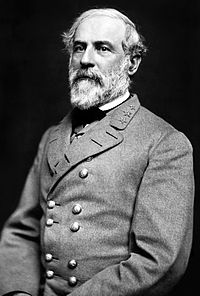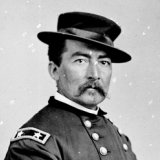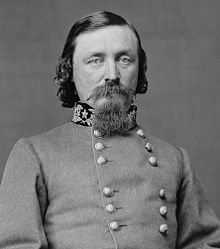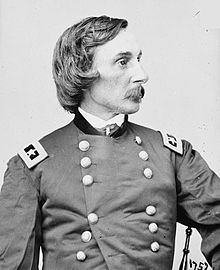Today, April 9, 1865, it is finally over. Confederate General Robert E. Lee surrenders his remaining

28,000 troops at Appomattox Court House, Virginia, to Union General Ulysses S. Grant, effectively ending the American Civil War. Finally forced to abandon the Confederate capital of Richmond, and effectively blocked from joining the surviving Confederate force in North Carolina, and harassed constantly by enthusiastic Union cavalry, Lee had no other option.

For more than a week, Lee had tried to outrun Grant to the west of Richmond and Petersburg in Virginia. After a ten-month siege of the two cities, the Union forces broke through the defenses and forced Lee to retreat. The Confederates moved along the Appomattox River, with Union General Philip Sheridan nipping at their heels all the way south. Lee’s army had little food, and they began to desert in

large numbers on the retreat. When Lee arrived at Appomattox, he found that his path was blocked. He had no choice but to request a meeting with Grant. In retreating from the Union army’s Appomattox Campaign, the Army of Northern Virginia had stumbled through the Virginia countryside stripped of food and supplies. At one point, Union cavalry forces under General Philip Sheridan had actually outrun Lee’s army, blocking their retreat and taking 6,000 prisoners at Sayler’s Creek (it was also known as Sailor’s Creek). Desertions were mounting daily, and by April 8 the Confederates were surrounded with no possibility of escape.
On April 9, Lee sent a message to Grant announcing his willingness to surrender. The two generals met in the parlor of the Wilmer McLean home at one o’clock in the afternoon.
They met at a house in Appomattox at 2:00 p.m. on the afternoon of April 9. Lee was resplendent in his dress uniform and a fine sword at his side. Grant arrived wearing a simple soldier’s coat that was muddy from his long ride. The great generals spoke of their service in the Mexican War, and then set about the business at hand. Grant offered generous terms. Officers could keep their side arms, and all men would be immediately released to return home. Any officers and enlisted men who owned horses could take them home, Grant said, to help put crops in the field and carry their families through the next winter. These terms, said Lee, would have “the best possible effect upon the men,” and “will do much toward conciliating our people.” The papers were signed and Lee prepared to return to his men.

In one of the great ironies of the war, the surrender took place in the parlor of Wilmer McClean‘s home. McClean had once lived along the banks of Bull Run, Virginia, the site of the first major battle of the war in July 1861. Seeking refuge from the fighting, McClean decided to move out of the Washington-Richmond corridor to try to avoid the fighting that would surely take place there. He moved to Appomattox Court House only to see the war end in his home.
Lee and Grant, both holding the highest rank in their respective armies, had known each other slightly during the Mexican War and exchanged awkward personal inquiries. Characteristically, Grant arrived in his muddy field uniform while Lee had turned out in full dress attire, complete with sash and sword. Lee asked for the terms, and Grant hurriedly wrote them out. All officers and men were to be pardoned, and they would be sent home with their private property–most important, the horses, which could be used for a late spring planting. Officers would keep their side arms, and Lee’s starving men would be given Union rations.
Shushing a band that had begun to play in celebration, General Grant told his officers, “The war is over. The Rebels are our countrymen again.” Although there were still Confederate armies in the field, and scattered resistance contin-ued for several weeks, for all practical purposes the Civil War had come to an end and the war was officially over. Four years of bloodshed had left a devas-tating mark on the country: 360,000 Union and 260,000 Confederate soldiers had perished during the Civil War.
To purchase a signed copy of Larry Auerbach’s novel “COMMON THREADS”, Click Here
Photo courtesy of wikipedia.com



